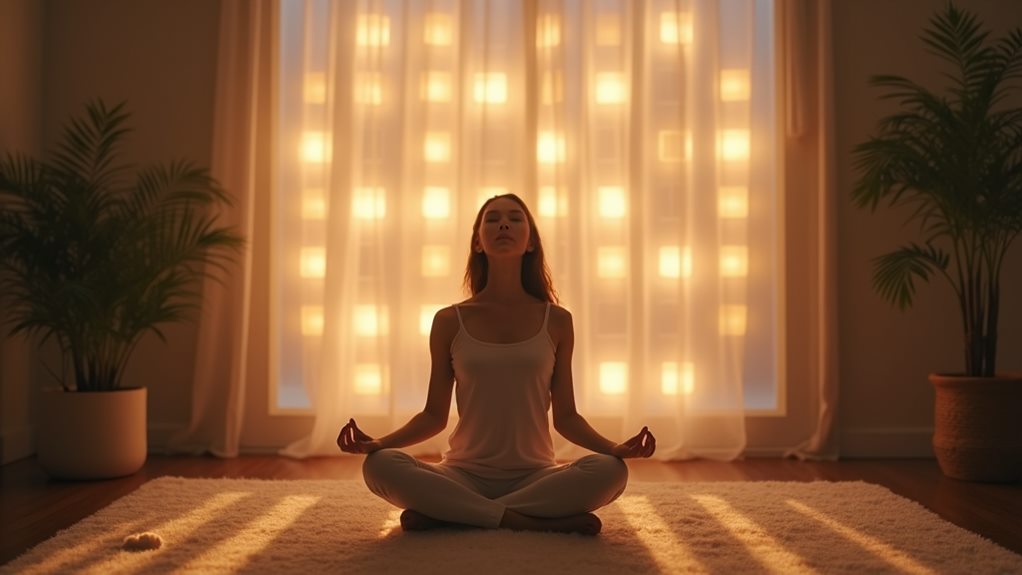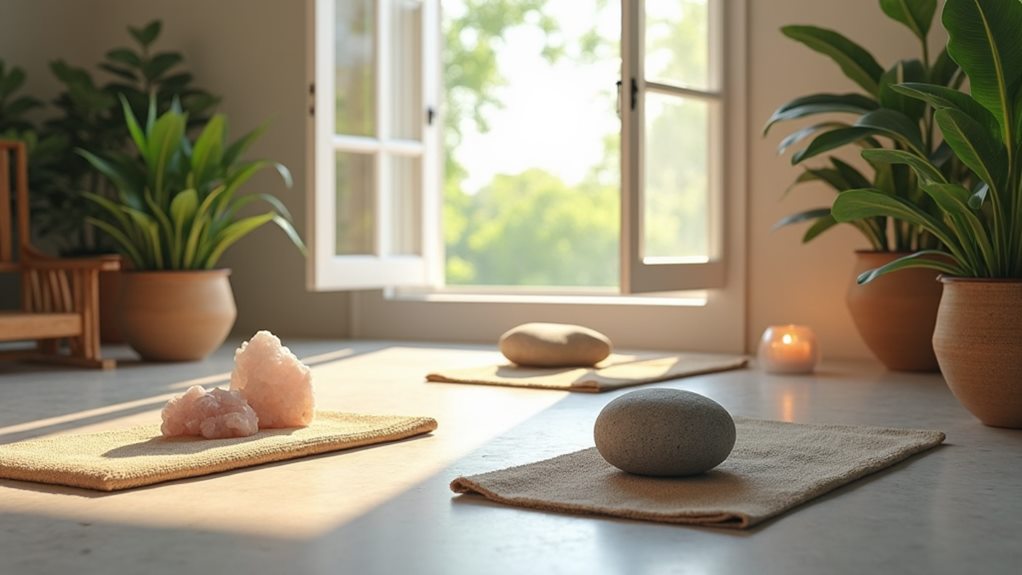
You’re missing out if you’re not using breathing exercises to crush anxiety. These techniques tap into your parasympathetic nervous system to calm your fight-or-flight frenzy. Imagine effortlessly balancing your heart rate and kicking stress to the curb just with your breath! By mastering methods like diaphragmatic and box breathing, you boost focus and mood while shaving off that pesky cortisol. It’s like giving your emotional state a warm hug. Plus, deep breathing isn’t just a relief—it’s a resilience-builder for future stress. Stay curious, because this is just the tip of the iceberg when it comes to mastering anxiety.
The Connection Between Breath and Anxiety
Ever wondered why stress makes your heart race and your breathing go all haywire? It’s because when anxiety kicks in, your brain hits the panic button, making your breath rapid and shallow—classic fight-or-flight mode. But here’s the kicker: you can reduce that anxiety with your breath. Techniques like the 4-7-8 method or diaphragmatic breathing work wonders by coaxing your body into relaxing. Why do they work? They activate that unsung hero, the parasympathetic nervous system, telling it, “Hey, time to chill out!” When combined with other methods like mindfulness meditation, they can significantly enhance relaxation. This hushes the cortisol, often dubbed the stress hormone, and helps squash anxiety.
But wait, there’s more—these breathing techniques also enhance something called heart rate variability, which is linked to better emotional balance. Regular practice not only dials down stress but also sharpens your focus and mood. It’s like giving your brain a spa day. So breathe in, breathe out, and wave goodbye to anxiety; it’s surprisingly straightforward.
Science Behind Breathing Techniques
You’ve just discovered how breathing can be your secret weapon against anxiety, but let’s uncover the science that makes these techniques incredibly effective. The magic lies in activating your parasympathetic nervous system, the body’s calming force. When stress sends your sympathetic nervous system into overdrive, breathing techniques like diaphragmatic breathing step in, counteracting the stress response and prompting a soothing state of calmness. Deep breathing can furthermore increase your oxygen intake, which is foundational for various relaxation methods and helps clear the mind effectively. Ever tried counting your breath with the 4-7-8 technique? It’s not just a numbers game. It drastically reduces perceived stress levels, enhancing your emotional well-being by emphasizing controlled inhalations and leisurely exhalations. Think of it as telling your body to pump the brakes.
These techniques also work wonders on your heart. Resonance breathing encourages slow and even breaths, sparking improvements in heart rate variability and dropping blood pressure levels—key factors in boosting mental health. Deep breathing even gives your vagus nerve a tickle, influencing mood regulation and slamming the brakes on anxiety. Clinical evidence backs it up: regular practice leads to better mood control, lower stress hormone levels, and beefed-up resilience against anxiety-related disorders. So, next time your stress peaks, remember—just breathe!
How Breathing Influences Emotions

More often than not, the way you breathe can dictate how you feel. Think of your breath as a remote control for your emotions. Regular, steady breathing is like pressing the “happy” button, while shallow, rapid breaths hit “stress” or “anxiety,” triggering a whirlwind of chaotic emotional states. Just like herbal teas can reduce stress and enhance your emotional well-being, breathing exercises offer a natural way to manage anxiety. Breathing exercises are more than just a wellness trend; they’re your secret weapon against unwanted stress and anxiety.
By consciously slowing down your breathing, you can trick your brain into believing you’re calm. Ever tried altering your inhale-to-exhale ratios? Exhaling longer than you inhale can be a game-changer, syncing your heart rate to a more relaxed rhythm. This magic of ratios taps into your body’s innate calming response, enhancing your ability to manage your emotional states.
Deep breathing exercises send an unmistakable signal to your nervous system that it’s time to chill. They reduce overall stress levels and promote better control over how you feel. Science backs you up on this one—controlled breathing can lead to significant mental health benefits, cutting down anxiety and boosting clarity of thought. So, why not take a deep breath and start influencing your emotions now?
Overview of Breathing Practices
When managing anxiety, mastering a few breathing exercises can be your ticket to tranquility. Breathing techniques are more than just taking a deep breath—they’re a secret weapon against stress. Techniques like 4-7-8 breathing, where you inhale for 4 seconds, hold for 7, then exhale for 8, serve to reduce anxiety by triggering your body’s relaxation response. Who wouldn’t want stress hormones to take a backseat?
Take box breathing, for instance. This method, often used by Navy SEALs (because if it’s good enough for them, it’s good enough for you), involves structured cycles of inhaling, holding, exhaling, and holding again. It’s like giving your racing heart a calming hug.
Then there’s diaphragmatic breathing—a fancy term for “breathing deeply.” By engaging your diaphragm, you physically alter your emotional state, calming your nervous system, and decreasing stress.
Breathing exercises are a win for mental health. They improve heart rate variability and cut down on perceived stress. And here’s the cherry on top: you can do them anywhere, anytime—no gear, no fuss. So, why let anxiety run the show when your breath holds the power?
Deep Breathing Benefits

While mastering breathing techniques provides a powerful toolset, understanding the specific benefits of deep breathing takes your anxiety management up a notch. It’s no secret that stress and anxiety jiggle like jelly at the most inconvenient times. Deep breathing, however, can tighten that wobble by promoting slower, deeper breaths that signal your nervous system to chill out. Imagine giving your body the equivalent of a gentle reset button. Not too shabby, right?
Engaging regularly in deep breathing workouts doesn’t just tap dance on stress. It also lowers your heart rate and blood pressure. That’s right, you’re not only reducing feelings of anxiety but also contributing to an overall sense of well-being like a serene yoga guru in full lotus mode. Intrigued yet?
Studies tip their hat to deep breathing for lowering cortisol levels—that pesky stress hormone that spikes when anxiety rears its ugly head. Plus, practice makes perfect. The more you engage in these relaxation techniques, the better you get at regulating your emotions and focusing like a laser beam. You’re essentially training your body to improve resilience against anxiety triggers. So, take a deep breath. You’re doing your future self a massive favor.
Techniques for Calming Anxiety
A multitude of calming techniques are at your disposal to tackle anxiety head-on, and breathing exercises are your secret weapons. By mastering breath control, you can transform from a bundle of nerves into a picture of zen-like tranquility. Diaphragmatic breathing is your go-to strategy for reducing stress with scientifically-backed results. Engage your diaphragm fully, and watch as your stress responses calmly retreat like they’re being shown the exit.
If you’re looking for something different, alternate nostril breathing might be your new favorite. This technique does wonders for balancing your body’s energy while keeping your nervous system as cool as a cucumber. Feel the tension melt away as you alternate which nostril you use to breathe in and out. It’s as if your anxiety got the memo to take a hike.
The great part? These aren’t just quick fixes. Regularly practicing these breathing techniques can give your mental health a serious upgrade. Say goodbye to high blood pressure and mental chaos, and hello to relaxation and crystal-clear emotional clarity. So, throw away that stress ball—true relief starts with a breath. Or two. Or, perhaps, a well-practiced routine.
Implementing Box Breathing

Ready to level up your anxiety management skills? Meet box breathing, the superhero of stress reduction! This simple yet powerful technique, also called square breathing, is your go-to tool. You just inhale deeply for four seconds, hold that breath for four seconds, exhale slowly for another four seconds, and hold again for four more – that’s it! This rhythmic breathing pattern works wonders by engaging your parasympathetic nervous system, leading to a lower heart rate and a calmer, more focused you.
Why box breathing? Well, research shows it significantly reduces perceived stress and anxiety levels, giving your emotional regulation a nice boost. It’s like having a personal therapist in your pocket! What’s even better? You can practice it anywhere – in traffic, during a hectic workday, or even while dealing with that annoyingly long line at the coffee shop.
Consistent practice transforms how your body responds to stress. Over time, you’ll feel more resilient and in control, laughing in the face of anxiety like it’s a bad joke. So, give box breathing a try. Your future calm self will thank you!
Resonance Breathing Explained
Try this technique for reducing anxiety: resonance breathing! It’s like a spa day for your nervous system. Breathe in for six seconds, then exhale for six. Simple, right? This exercise combines breath control with science, helping your heart rate variability dance to a calmer beat. With resonance breathing, you create a harmonious rhythm that rivals the smoothest jazz, putting your body in a coherent breathing state.
The sympathetic nervous system, often in overdrive during stress, takes a backseat, letting your body chill. When you practice, you can lower cortisol levels—the nasty stress hormone wreaking havoc on your peace of mind. Just ten magical minutes of resonance breathing can melt away anxiety like butter on a hot skillet, leaving you relaxed, and maybe a bit smug about your newfound tranquility.
Plus, it gives your vagal tone a boost. Trust us, your autonomic nervous system will thank you for the tune-up, balancing stress responses like a seasoned yogi. So, next time you’re feeling frazzled, why not give resonance breathing a whirl? It’s a simple, effective tool to keep anxiety in check and reclaim your chill, all in a day’s breath work!
Guided Meditation and Breath

Imagine a soothing voice guiding you through a mental oasis, using the power of guided meditation paired with intentional breaths to dismantle anxiety piece by piece. Feels pretty incredible, right? That’s because when you fuse guided meditation with breathing exercises, it’s like giving your brain a spa day. You’re not just focusing on your breath; you’re also reducing stress and sculpting your emotional resilience. Studies even show that this magical duo takes a sledgehammer to stress hormones like cortisol, leaving you zen and focused.
With guided meditation directing the show, deep breathing techniques shine at center stage. Together, they tune up your heart’s rhythm, boosting heart rate variability and letting your autonomic nervous system off the stress hook. You’ll notice anxiety begin to loosen its grip while calmness makes its grand entrance. It’s not just hearsay—participants in research stroll away from sessions with measurable improvements in anxiety levels.
Practicing Breath Focus Techniques
When it comes to melting anxiety away through breath focus techniques, it’s about time to flip the script on stress. You hold the power, with just a breath, to transform tension into tranquility. Breath control helps you take the reins, allowing your body to alleviate stress like a pro. Focusing on the rhythm and depth of your breathing isn’t just child’s play—it’s an art that stabilizes your nervous system and helps you stay cool as a cucumber.
Got just 5-20 minutes to spare? Perfect! Engage in breath focus daily, and you’ll enhance your emotional regulation abilities in no time. As you become a maestro of your own respiration, you’ll notice stressors becoming mere background noise. Plus, by lowering your heart rate and high blood pressure, you’re giving your mental and physical health a much-needed spa day.
Ever heard of equal breathing? It’s where you match your inhalations and exhalations in duration—a technique that truly makes your stress response sit down and behave. We’re talking genuine calmness here. Consistent practice of these techniques builds a resilience that can buffer life’s hiccups, leaving you more prepared than a Swiss Army knife on a camping trip.
Lengthening Your Exhale

Ever wondered why some people seem to stay unfazed in the face of stress? The secret might just be breath control, specifically, the art of lengthening the exhale. By extending your exhale, you’re giving your parasympathetic nervous system—the calmness champion—a green light to take charge. This isn’t just feel-good mumbo jumbo. Science backs it up: longer exhalations significantly drop heart rate and blood pressure, slicing through anxiety like a hot knife through butter.
Picture this: inhale slowly to the count of four, but when you exhale, aim for an elegant eight. It’s like turning your breath into a calming symphony. And you don’t need to quit your day job to make it work—just 2-5 minutes of this daily practice can take cortisol, that pesky stress hormone, down a notch.
Enhancing Mental Health
Taking control of your breath doesn’t just calm your nerves; it opens the door to a brighter state of mind. By adopting breath control techniques, you can reduce stress and enhance your mental health significantly. Picture cortisol, the stress hormone, quietly retreating while your anxiety loosens its grip on your days. Deep breathing’s not just a gimmick; studies show it lowers cortisol levels, turning chaos into tranquility.
Imagine gaining the superpower of increased heart rate variability, which translates into improved emotional resilience. You’ll face life’s curveballs with the finesse of a seasoned juggler, cool, calm, and collected. Stressful situations will no longer leave your brain in a fog. With each controlled breath, your focus sharpens, your attention span stretches, and decision-making becomes as smooth as butter.
Incorporating these breathing techniques into your daily routine isn’t a chore; it’s your secret weapon against anxiety. You’re not just reacting to stress, but proactively ensuring your mental health stays in awesome shape. So, take a deep breath, let it out, and start your journey toward a clearer, more serene headspace. Trust me, your future self will thank you.
Exploring Additional Resources

Amid the chaos of everyday life, finding the right resources to help manage anxiety can feel like searching for a needle in a haystack—but not if you know where to look. Imagine this: your smartphone as your anxiety-fighting sidekick. Apps like Headspace and Calm don’t just offer relaxation—they offer structured breathing techniques tailored to ease your worries. And, hey, who wouldn’t want a personal guide to calm in their pocket?
Don’t forget the power of community support. Join groups where people swap help and tips—because nothing says “you’re not alone” like connecting with someone who truly gets it. Sharing techniques and stories can turn breathing exercises from solitary to social, giving a fresh twist to fighting anxiety.
For the data geeks, dive into research studies where breathing patterns have swooped in to save the day. These studies show remarkable improvements in things like heart rate variability—the science-backed way to say, “Hello, calm!”
Lastly, keep an eye on mental health blogs. They dish out the latest techniques and medical advice faster than today’s fastest Wi-Fi. Stay informed, stay calm, and keep breathing your way to a more anxiety-free life!
Breathing Reduces Anxiety Symptoms
The power of breathing exercises in alleviating anxiety symptoms is both profound and scientifically backed. With techniques ranging from deep breathing and resonant breathing to the popular 4-7-8 method, each approach activates the parasympathetic nervous system to promote relaxation and counteract the stress and anxiety responses. Research has demonstrated that these exercises can result in significant physiological changes, such as reduced heart rate variability and lower cortisol levels, indicators of stress reduction. Furthermore, regular engagement in these practices enhances emotional regulation and increases mental clarity, marking them as vital tools in managing anxiety.
Breathing exercises offer an accessible, effective, and non-invasive method to mitigate anxiety and stress in everyday life. By integrating these practices into one’s daily routine, individuals can gain greater control over their emotional wellbeing and enhance their overall quality of life. The consistent application of breathing techniques not only provides immediate relief from anxiety but also cultivates long-term resilience against stressors. As supported by clinical research, breathing exercises are a reliable strategy within therapeutic settings, providing patients with the means to manage anxiety symptoms naturally. The widespread adoption of such techniques underscores their importance, acting as a testament to the profound impact simple, mindful breathing can have on mental health.














